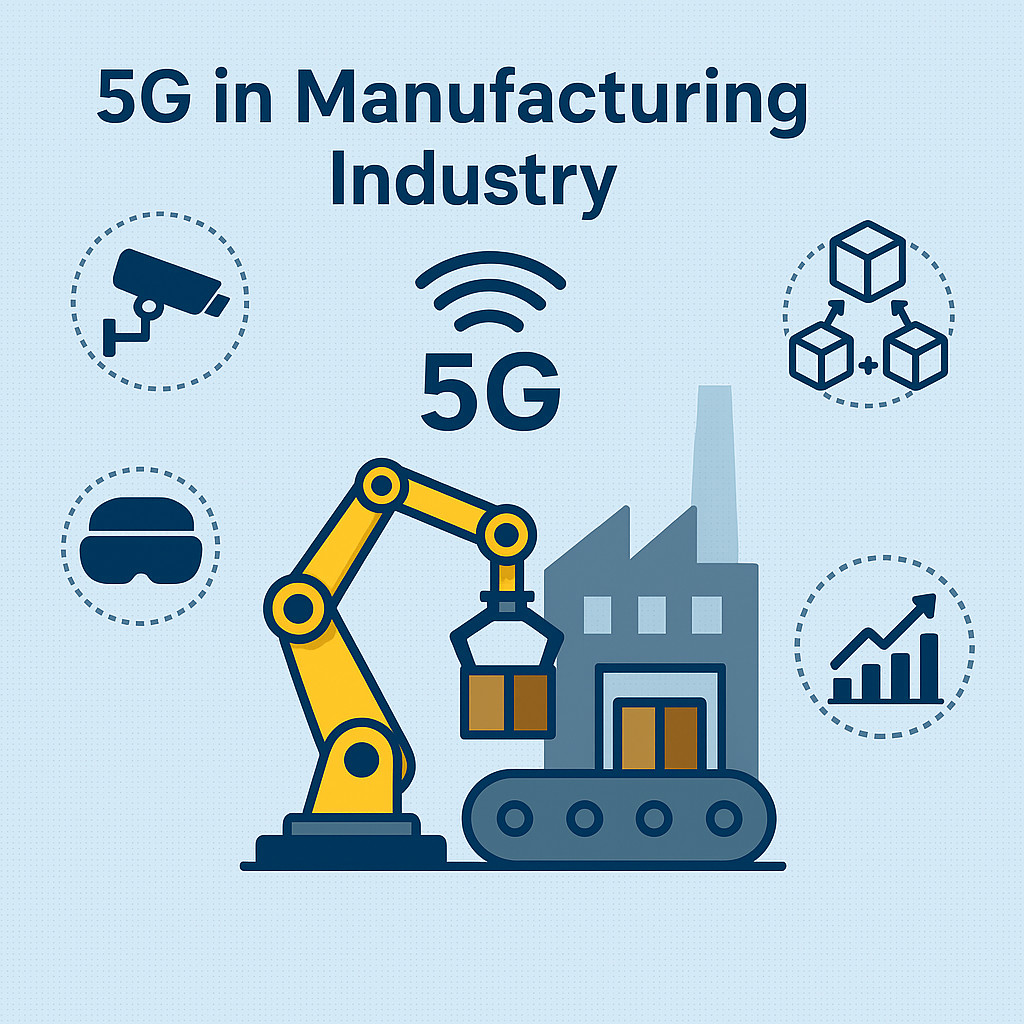5G in Manufacturing Industry
Introduction: The Industrial Internet Breakthrough
5G in Manufacturing Industry is more than a buzzword—it’s a revolution in progress. As industrial automation evolves under the banner of Industry 4.0, fifth-generation wireless technology is emerging as the backbone that enables smart factories, intelligent supply chains, and real-time decision-making.
Unlike its predecessors, 5G is engineered to meet the exacting demands of modern manufacturing environments. Its ultra-low latency, high data capacity, and seamless device connectivity allow manufacturers to reimagine operations—from the factory floor to global logistics.
With the integration of 5G, manufacturers are moving beyond simple automation to create intelligent, responsive ecosystems that optimize production, reduce costs, and boost quality. This next-gen connectivity is enabling transformative applications such as augmented reality maintenance, AI-powered video analytics, and predictive supply chain systems.
In this in-depth guide, we’ll explore how 5G in Manufacturing Industry is unlocking new efficiencies and setting the stage for a smarter, more agile industrial future.
What Makes 5G a Game-Changer for Manufacturing?
Before diving into specific use cases, let’s understand why 5G stands out:
- Ultra-low latency (as low as 1ms) means real-time responses for robotics and automated systems.
- High bandwidth and speed support data-heavy operations like video monitoring and AI-based quality control.
- Massive device connectivity enables thousands of IoT sensors and devices to communicate simultaneously.
- Network slicing allows manufacturers to create dedicated private networks optimized for their operational needs.
- Edge computing compatibility enables data to be processed closer to where it is generated—boosting speed and security.
These characteristics make 5G not just an upgrade from 4G, but a complete paradigm shift for smart manufacturing.
1. Real-Time Video Monitoring and AI-Powered Analytics
In traditional manufacturing setups, quality control and equipment surveillance often relied on manual inspections or time-delayed reports. 5G enables high-resolution, real-time video streaming powered by AI-based analytics. Cameras placed across the factory floor can:
- Detect defects or anomalies in real-time
- Monitor worker safety and ensure compliance
- Automate visual inspections
AI at the edge can process video data instantly—reducing response time and enabling preventative actions. For example, if a robotic arm is malfunctioning, the system can automatically halt the process or notify an operator before a breakdown occurs.
Moreover, perimeter monitoring using smart sensors and 5G-connected alarms ensures that sensitive or hazardous zones are only accessed by authorized personnel.
2. Smarter Supply Chain Visibility and Optimization
Supply chain management is a cornerstone of efficient manufacturing. With 5G-powered IoT devices and sensors, manufacturers can track goods, inventory, and raw materials with pinpoint accuracy. These sensors can monitor:
- Location and movement of shipments
- Environmental conditions like temperature and humidity
- Delays, route changes, or disruptions in real-time
5G enhances this by providing continuous, reliable connectivity even in remote warehouses, vehicles, or shipping containers.
Imagine a scenario where a delay in delivery triggers an automatic update to the production schedule, alerts supply chain managers, and reroutes orders in real time—without human intervention.
This level of automation and responsiveness was previously unthinkable with 4G.
3. Delivering Tangible ROI with Connected Ecosystems
For manufacturers, every technological investment must justify itself through measurable return on investment (ROI). 5G delivers on this promise in multiple ways:
- Reduced downtime through predictive maintenance
- Improved product quality via real-time monitoring
- Energy and resource efficiency with smart energy grids and usage tracking
- Labor efficiency by reducing manual interventions and errors
By creating a fully connected ecosystem of machines, tools, workers, and systems, 5G reduces wastage, accelerates throughput, and enables better decision-making at every level of the factory.
4. Augmented Reality (AR) for Maintenance and Troubleshooting
AR in manufacturing is already being used for training, assembly instructions, and repair guides. But with 5G, AR becomes far more powerful:
- Low latency allows AR headsets to stream live data and guides with zero lag
- Remote experts can guide on-site workers through complex repairs in real-time
- Sensor data overlays enable technicians to see diagnostics visually over equipment
For instance, a technician wearing an AR headset can identify a faulty motor, view past maintenance records, receive visual step-by-step repair instructions, and order parts—all without leaving the factory floor.
Such capabilities drastically reduce downtime and enhance workforce productivity.
5. Supporting New Business Models and Roles
5G also opens up new revenue streams and operating models for manufacturers and telecom providers:
- Telecom operators can become platform providers and service enablers, delivering connectivity solutions tailored for industrial clients.
- Manufacturers can move from traditional product-based models to service-based offerings, such as “machines-as-a-service” or outcome-based contracts.
- Custom private networks allow factories to secure mission-critical operations without relying on public infrastructure.
This transition also requires upskilling the workforce, redefining roles around data analysis, cybersecurity, and systems integration.
6. Empowering the Next Generation of Smart Factories
The future of manufacturing is sensor-rich, data-driven, and automated. In a 5G-enabled smart factory:
- Sensors track every aspect of the environment: air quality, vibration, temperature, equipment wear
- Machines self-report performance metrics and maintenance needs
- Supply chain nodes communicate autonomously
- AI engines optimize energy usage, schedules, and logistics
This convergence of 5G, IoT, AI, and edge computing forms the backbone of Industry 4.0, making factories more agile, responsive, and sustainable.
7. Global Momentum and Future Outlook
Countries like the U.S., Germany, South Korea, Japan, and China are already investing heavily in 5G testbeds and pilot projects across manufacturing hubs. India is also accelerating its 5G deployment roadmap, collaborating with private firms to set up smart manufacturing clusters.
According to several market research studies, 5G is expected to generate billions in added value for the global manufacturing sector in the next decade—through productivity gains, cost savings, and innovation.
Key trends to watch:
- Rise of autonomous mobile robots (AMRs)
- Deployment of digital twins for real-time simulation and diagnostics
- Increased use of blockchain for supply chain transparency
Conclusion: 5G as a Catalyst for Industrial Reinvention
5G is not just a faster version of 4G—it is a foundational enabler of digital transformation in the manufacturing industry. It bridges the gap between physical production and digital intelligence, unlocking new levels of agility, visibility, and performance.
From predictive maintenance and immersive training to real-time supply chain orchestration and AI-driven automation, 5G is reshaping how factories operate and compete.
For manufacturers ready to embrace this change, the journey into smart manufacturing begins with understanding the power of 5G—and acting on it.
See also: What is Industry 4.0; Explanation of Fourth Industrial Revolution
If you found this article insightful, explore more on IoT Applications in Manufacturing, or subscribe to our YouTube channel for in-depth video tutorials.










Leave a Review